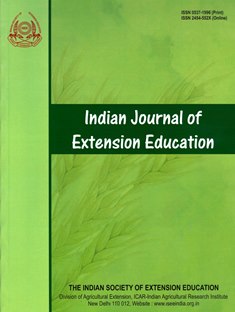Adoption of Artificial Insemination Among Large Ruminants in Arid Western Rajasthan, India
DOI:
https://doi.org/10.48165/IJEE.2023.59114Keywords:
Arid region, Artificial insemination, Cow, Buffalo, Farming system, Subsistence agricultureAbstract
This study estimated the adoption rate of Artificial Insemination (AI) among large ruminants based on primary data collected from 200 farm households in Jodhpur district from 2019 to 2022. The composition of cow and buffalo population was 74 and 26 per cent in the study villages. 56 per cent farmers in cows and 13 per cent in buffaloes adopted AI with a success rate of conception after first insemination of 31 per cent in cows and 22 per cent in buffaloes. AI cost ranged from Rs. 400-800/- and Rs. 500-1000/- per insemination in cows and buffaloes respectively. Breeding cost through pedigreed bull was comparable to insemination in both cows and buffaloes. Subsistence mode of livestock rearing and natural grazing on community pastures were the main reasons for low adoption rate of AI. Farmers ensured that their buffaloes were sired only through pedigreed bulls. Since, pedigreed bulls were not available in all villages, their availability in villages or at the selected farmers on payment basis is required for genetic improvement of cattle.
Downloads
References
th Livestock Census (2019). All India Report: Ministry of Agriculture, Department of Animal Husbandry, Dairying & Fisheries, Krishi Bhawan, New Delhi, India.
Chander, M., Dutt, T., Ravikumar, R., & Subrahmanyeswari, B. (2010). Livestock technology transfer service in India: A review. Indian Journal of Animal Sciences, 80, 1115-1125.
Dixit, V. B., Sharma, R. K., Bharadwaj, A., Sikka, P., & Phulia, S. K. (2016). An innovative approach to measure skill about artificial insemination in buffaloes. The Indian Journal of Animal Sciences, 86(2), 213-215.
George, P., & Robin, S. (2020). Post-insemination management of cattle. In SDSU Extension. Beef. Retrieved September 15, 2022. https://extension.sdstate.edu/sites/default/files/2021-05/S-0013- 27.pdf.
Gowda, M. J. C., & Samanta, R. K. (2002). Para-technicians as alternative veterinary service for livestock management. LEISA India, 4(1), 27-28.
Gupta, R. K., Saha, A., Tiwari, P. K., Dhakre, D. S., & Gupta, A. (2020). Entrepreneurial behaviour of tribal dairy farmers in Balrampur district of northern hill region of Chhattisgarh. Indian Journal of Extension Education, 55(4), 25-30.
Gupta, R. K., Saha, A., & Tiwari, P. K. (2021). Identifying the entrepreneurship behavioral dimension of tribal dairy farmers in Balrampur district of Chhattisgarh. Indian Journal of Extension Education, 57(4), 80-84.
Gupta, R. O., Attupuram, N. M., Saha, S., & Bhosale, V, P. (2017). Dissemination of genetics through AI in India- Innovative Approaches, Indian Dairyman, 11, 68-74.
Hamdani, S. A. (2013). Role dynamics of para-veterinary professionals in relation to delivery of livestock health services. PhD Thesis, Indian Veterinary Research Institute, Izatnagar, Uttar Pradesh.
Ibrahim, N., Hailu, R., & Mohammed, A. (2014). Assessment of problems associated with artificial insemination service in selected districts of Jimma zone. Journal of Reproduction and Infertility, 5(2), 37-44.
Jarial, S., Kumar, A., & Padmakumar, V. (2015). Assessment of feeding practices, nutritional status and gap for dairy buffaloes in hilly districts Tehri Garhwal and Pithoragarh of Uttarakhand, India. Indian Journal of Animal Sciences, 83(9), 960-963.
Lawrence, F. G., Mutembei, H. M., Lagat, J., Mburu, J., Amimo, J., & Okeyo, A. M. (2015). Constraints to use of breeding services in Kenya. International Journal of Veterinary Sciences, 4(4), 211-215.
Manjunatha, B. L. (2021). Livelihood analysis of existing farming systems in Jodhpur and Jalore districts. In Annual Report of CAZRI 2021 published by Central Arid Zone Research Institute, Jodhpur, India, pp 133-134.
Manjunatha, B. L., Shamsudheen, M., Sureshkumar, M., & Tewari, P. (2021). Ecological, economic and socio-cultural sustainability of different livelihood options and enterprises practised by pastoralists in Banni grasslands of Gujarat. Indian Journal of Animal Sciences, 91(4), 305-312.
Manjunatha, B. L., Shamsudheen, M., Sureshkumar, M., Pratibha, T., Devi, D., & Yadav, O. P. (2019). Occupational structure and determinants of household income of pastoralists in Banni
grasslands in Gujarat. Indian Journal of Animal Sciences, 89(4), 453-458.
Manjunatha, B. L., Sureshkumar, M., Pratibha, T., Devi, D., & Yadav, O. P. (2019). Livestock population dynamics in Banni grasslands of Gujarat. Indian Journal of Animal Sciences, 89(3), 319-323.
Ravikumar, R. K., & Chander, M. (2011). Livestock extension education activities of the state departments of animal husbandry (SDAH) in India: A case of Tamil Nadu state. Indian Journal of Animal Sciences, 81(7), 757-62.
Saharia, K. K. (1990). A study on the organizational climate and role performance as perceived by veterinarians for dairy development in Assam. National Dairy Research Institute, Karnal.
Samsuddin, M., Bhuian, M. M. U., Chanda, P. C., Alam, M. G. S., & Abedin, J. (1997). Fertility related factors at artificial insemination in cattle in Bangladesh. Proceedings of the Third Animal Scientific Conference Bangladesh. Society for Veterinary Education and Research, Mymensingh, Bangladesh, pp 21-33.
Singh, T., Kaur, M., & Singh, G. (2021). Extent of adoption of happy seeder technology among the farmers of Punjab (India). Indian Journal of Extension Education, 57(4), 75-79.
Verma, A. P., Meena, H., Patel, D., & Kar, P. (2020). Constraints perceived by field veterinarians for providing animal health services in Haryana and Punjab state. International Journal of Livestock Research, 10(3), 152-159.
Downloads
Published
Issue
Section
License

This work is licensed under a Creative Commons Attribution-NonCommercial-NoDerivatives 4.0 International License.

